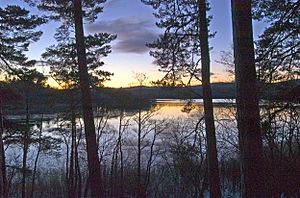Loch Davan facts for kids
Quick facts for kids Loch Davan |
|
|---|---|

Dawn at Loch Davan
|
|
| Location | Grampian, Scotland |
| Coordinates | 57°5′40″N 2°55′23″W / 57.09444°N 2.92306°W |
| Type | freshwater loch |
| Primary inflows | Red Burn and Logie Burn |
| Primary outflows | Monandavan Burn |
| Basin countries | Scotland |
| Max. length | 0.75 mi (1.21 km) |
| Max. width | 0.33 mi (0.53 km) |
| Surface area | 42.2 ha (104 acres) |
| Average depth | 4 ft (1.2 m) |
| Max. depth | 9 ft (2.7 m) |
| Water volume | 25,000,000 cu ft (710,000 m3) |
| Shore length1 | 3.3 km (2.1 mi) |
| Surface elevation | 167 m (548 ft) |
| Islands | 0 |
| 1 Shore length is not a well-defined measure. | |
Loch Davan is a small, freshwater loch (which is a Scottish word for lake). It has a triangular shape. You can find it about 5 miles (8 km) northeast of Ballater, in Scotland. It sits right next to another loch called Loch Kinord.
Loch Davan is about 0.75 miles (1.2 km) long. It was formed a long time ago by a glacier. The loch is part of the Muir of Dinnet National Nature Reserve. This means it's a special place where nature is protected.
Contents
Plants and Animals of Loch Davan
Because Loch Davan is not very deep, sunlight can reach the bottom. This helps many different water plants grow there.
Aquatic Plants
You might see plants like water lobelia, quillwort, and shoreweed. These plants live completely underwater or have parts floating on the surface.
Plants Around the Shore
Around the edges of the loch, you'll find other types of plants. These include reeds, sedges, horsetails, and bulrushes. There are also willow bushes growing nearby.
Animals in and Around the Loch
Loch Davan is home to various animals. You can find pike, which are a type of fish. Otters also live here, enjoying the water and catching fish. The loch is a stop for migrating geese and other kinds of wild birds.
History and Archaeology
Loch Davan has some interesting history, especially on its northern shore.
The Heugh: A Medieval Site
On the northern shore, you can see the remains of an old medieval home. It was surrounded by a ditch filled with water, like a small castle. This place is known as The Heugh.
The Hall of Logy Rothwayne
Historians believe The Heugh was once called the Hall of Logy Rothwayne. This was an important place during the Battle of Culblean in 1335. It was likely the main base for Andrew de Moray, a leader in that battle.
Loch Davan Survey
Scientists have studied Loch Davan to learn more about it.
The 1905 Survey
On July 10, 1905, two people named T.N. Johnston and L.W. Collett surveyed the loch. They measured its depth and other features.
Sir John Murray's Bathymetrical Survey
Their work was part of a bigger project. This was Sir John Murray's Bathymetrical Survey of Fresh-Water Lochs of Scotland. This large survey took place between 1897 and 1909. It helped create detailed maps of many Scottish lochs.


